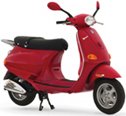There we were, on the plane, waiting for clearance to take off. One hour goes by, then two. Can you say hot box of panic and annoyance? The captain comes on over the loudspeaker: It's nothing major, but it needs to be fixed. If you have ever taken a 12-hour flight, you know that you don't want to be on the plane one single second longer than you have to. The flight attendants flipped on the on-board movies in desperation.
Thank God it's "Alfie." The tension and massive claustrophobia breeze out of me like air out of a bagpipe when I see Jude Law preening in front of the camera in this confectionary piece of cinema. I had wanted to see the movie when it first came out for only one reason: Alfie's Vespa. Indeed, the appearance of the jaunty scooter might be the only redeeming factor in the pointless movie. But sitting there in air traffic limbo, I swear I could stretch my legs to China, and feel a faint stream of wind on my face as I imagined tooling around Manhattan on the back of Alfie's ride, a '60s vintage, blue and white Vespa.
Vespas have always been cool. Their history is fascinating. The original designer, Corradino D'Ascanio, created the scooter after World War II left the Italian roads in shambles and the economy incredibly weak. The Italians needed a cheap but hardy machine to get around. According to Vespa's Web site, D'Ascanio's boss, Enrico Piaggio, upon seeing the unibody steel chassis, with its airplane-like front forked wheel, proclaimed, "Sembra una Vespa!" Translation: It looks like a wasp. The name stuck, and Italians grew to love the spunky little things; by the mid-'50s, millions had been sold and were being produced all over Europe. They had cameo roles in a variety of movies before "Alfie"; like "Roman Holiday" starring Audrey Hepburn and the cultish "Quadrophenia."
By 1984, Vespa and the United States had a tiff over emissions (Vespas at that point were like lawn mowers, spewing, spewing), and the hip scooter maker packed its hand-tooled leather bags and left. In 2001, to much acclaim, Vespa returned to kiss and make up. The company began offering new scooters to the American market with advertising slogans like, "Imagine your life, only better" and "Imagine going where you want ... when you want." Vespa keyed into the Eurotrash leanings in America, and is doing very well. Over 50,000 Vespas were sold in the United States last year and the number of scooter clubs grows daily.
Of course, we Americans take it to an extreme. In September of last year, a group of Vespa devotees completed a cross country "Cannonball Run 2004" from Virginia Beach, Va., to the Santa Monica Pier in Santa Monica, Calif. That meant driving 300 miles a day, rain or shine, on their little scooters! Or, not-so-little scooters. Some rode the Granturismos, which have a four-stroke, four-valve 200cc engine, 12-inch wheels, and can go up to 70 miles per hour! They seem to make great touring bikes with amazing gas mileage—72 miles per gallon; and an indestructible constitution.
This is nothing compared to Giorgio Bettinelli, an Italian traveler who has essentially driven around the world on his Vespa: Italy to Vietnam in 1992, the Arctic Circle to Tierra del Fuego next, and finally, Australia to South Africa via Asia. He completed that journey in 2001, and has written a book about the experience. For more information about Bettinelli, see http://www.giorgiobettinellifansclub.it
Now that I've convinced you how amazing these scooters are; you'll want to know how much they cost. Kind of a lot, for such small things. Vintage Vespas run in the $3,000 range for mint vintage scooters. Meanwhile, a brand new Vespa ET2 will put you out around $3,500.
Visit Vespa of New Orleans at 3540 Toulouse St., 504-483-6776, for new and used Vespas, or see vespaneworleans.com.



Comments
Use the comment form below to begin a discussion about this content.
comments powered by Disqus